Suppose your job requires you to sit at a desktop for long hours, and you are not practicing an ergonomically perfect sitting position. There’s a 90% chance of developing musculoskeletal pain in that case. You may suffer from pain like lower back pain, upper back pain around your shoulder blade, or Neck pain; in the worst case, you may get a headache.
In this article, we will learn the correct ergonomic posture for computers that you must adopt while working in front of your computer. We will learn each component of good posture from head to toe. So, let us start.
- Perfect sitting position for computer
- 1) The correct leg position for achieving a perfect sitting position while using a computer
- 2) Body and chair position according to desk ergonomics
- 3) Keyboard and arm position is important component of desktop ergonomics
- 4) To maintain correct sitting posture, ensure your neck and monitor are positioned correctly
- How to find chair height and desk height best sitting position
Perfect sitting position for computer
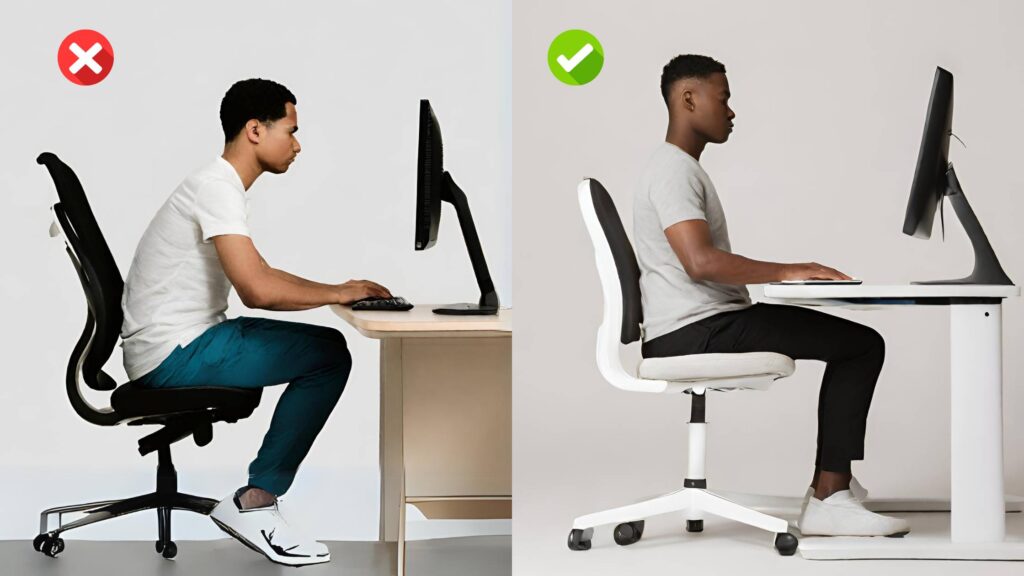
In the figure above, you can see two different sitting positions on the desktop: a bad posture and a friendly one. Desktop ergonomics are designed to make our body’s joints neutral and comfortable.
The correct posture maintains the spine’s natural curve and minimizes stresses on the human body, drastically reducing musculoskeletal pain . The components of a perfect sitting position for a computer include:
- Feet flat on the floor.
- Knee bent at 90 degrees.
- Back straight and supported over the backrest of the chair.
- The forearm is comfortably supported with the elbow at 100 -110 degrees bending.
- The head and neck are almost straight.
Now, let us dive deeper into it and study each component.
1) The correct leg position for achieving a perfect sitting position while using a computer
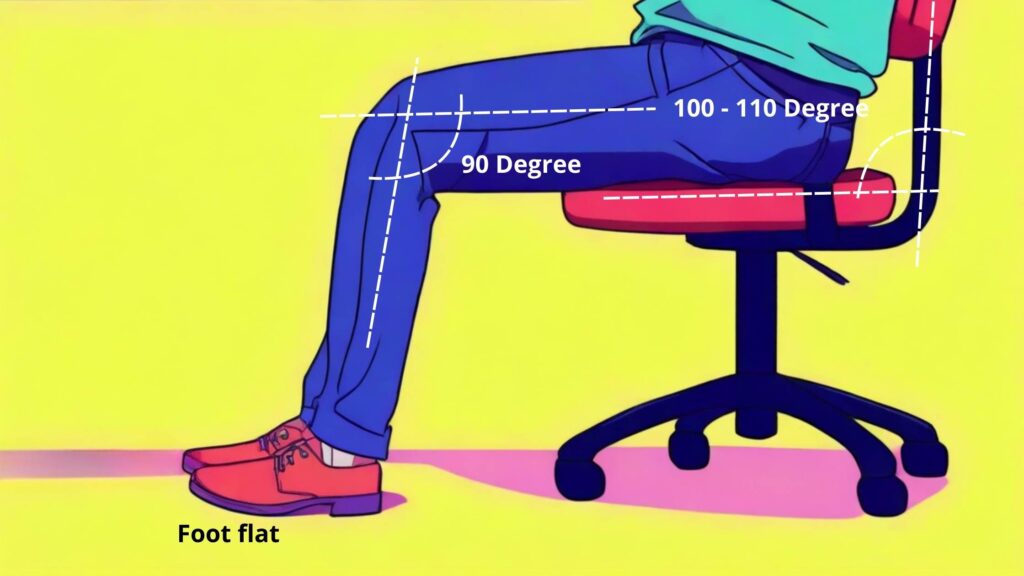
Proper leg position is one key component of good ergonomics. When sitting at a desk, your feet should be flat on the floor, and your knees should be at a 90-degree angle. This position ensures that your weight is distributed evenly across your feet and your knees are not strained.
It’s also essential to ensure that your hips are at a 90-degree angle, which can be achieved by adjusting the height of your chair. When your hips are at the right angle, they help reduce the strain on your lower back and prevent you from slouching forward. Additionally, having your feet supported and rested minimizes the pressure on your lower legs and feet, preventing discomfort, swelling, and even blood clots.
2) Body and chair position according to desk ergonomics
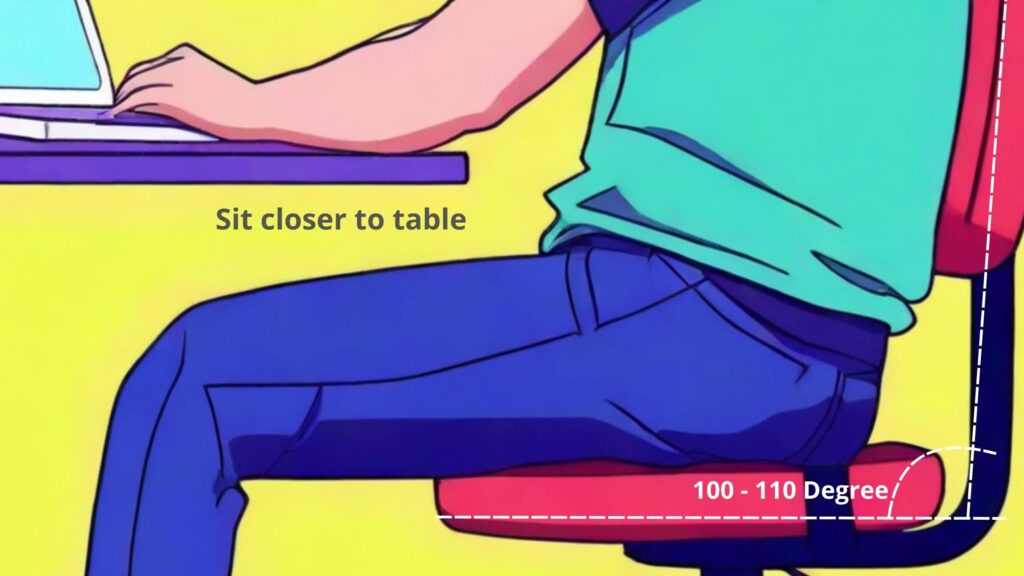
It is essential to ensure that your chair adequately supports your back. To do this, ensure the chair’s backrest supports your back well and gets maximum contact. First, adjust the backrest to a 100- to 110-degree angle. If your chair does not have the option to adjust the angle, you can use a lumbar support pillow to help support your lower back.
To achieve the optimum backrest position, follow the sit-slide-lean rule. First, sit on the chair, slide your buttock to the back, and then lean back on the backrest. This will help you achieve maximum contact with the backrest and ensure your back is well-supported.
3) Keyboard and arm position is important component of desktop ergonomics
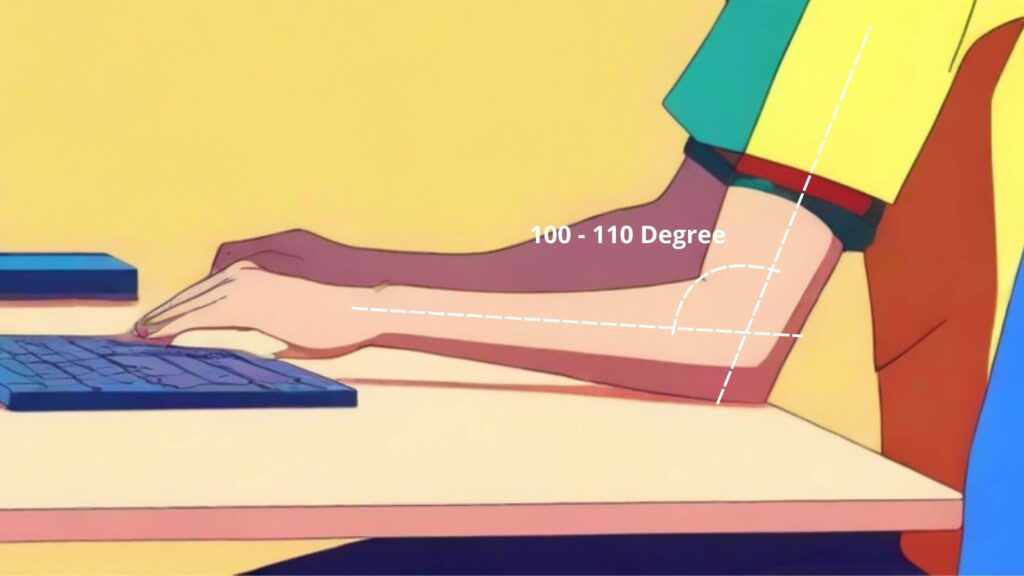
While working on the keyboard, supporting the forearm drastically reduces the stress on the shoulder and elbow to hold the forearm. If the keyboard is too high, it can lead to tension in the shoulders and neck, while a keyboard that is too low can cause strain on the wrists and forearms. This can be achieved by sitting closer to the desk.
The wrists should be kept straight and preferably supported over the soft mouse pad when working on the mouse. In my clinical practice, I have found that the wrong keyboard position can lead to a wrist pain condition known as carpal tunnel syndrome. Fortunately, these 5 Easy Carpal Tunnel Exercises for Wrist Pain Relief will help ease your pain.
4) To maintain correct sitting posture, ensure your neck and monitor are positioned correctly

Position your monitor so the text’s first line lies at the eye’s level. This ensures less neck bending. Place the monitor 20 to 30 inches away from the head. We highly recommend taking a 5-minute break every 30 minutes and performing these 4 quick neck exercises.
How to find chair height and desk height best sitting position
Adjusting the height of the chair and your desk is crucial to achieve the perfect sitting position. No height fits everyone; you must adjust it based on height. You can use an online desk height calculator to find the chair height and desk height and monitor height according to your height.
Chair height
The height of the chair alters this ideal leg position. If you are sitting on a low-height chair, your knee will be flexed to more than a 90-degree angle, and obviously, your foot will not remain flat on the floor.
On the contrary, if you are sitting on a very high chair, your knee will be in a 90-degree bending position, but as your legs will be hanging, your foot will not get good support, and this will cause strain of muscles around the knee, thigh, and lower leg.
To prevent this, we should always use a chair that can be adjusted in height. You should adjust the height of the chair to achieve an ideal leg position: the foot placed flat on the floor with the knee and hip in a comfortable 90 degrees of the next position. Your ankle should also be in a neutral position.
So, next time you buy a chair for your office, try to get an organically designed chair that allows you to increase or decrease the height of your sitting level.
Height of desk and monitor

The desk’s height is usually not adjustable, so you should choose the correct height before installation. Use our online desk height calculator to determine what height suits you. Similarly, you can find the right height of your computer monitor using the same calculator and adjust the height.
But what if you are using a laptop?
You can increase or decrease the monitor’s height using a foldable tabletop stand for a laptop or place the laptop computer over the stack of books. I am ending this article with a video on the perfect sitting position for a computer.
Keep Reading: Healthy Muscles? 2-min Walk or Squat Every 30-min is Enough for Desk Job

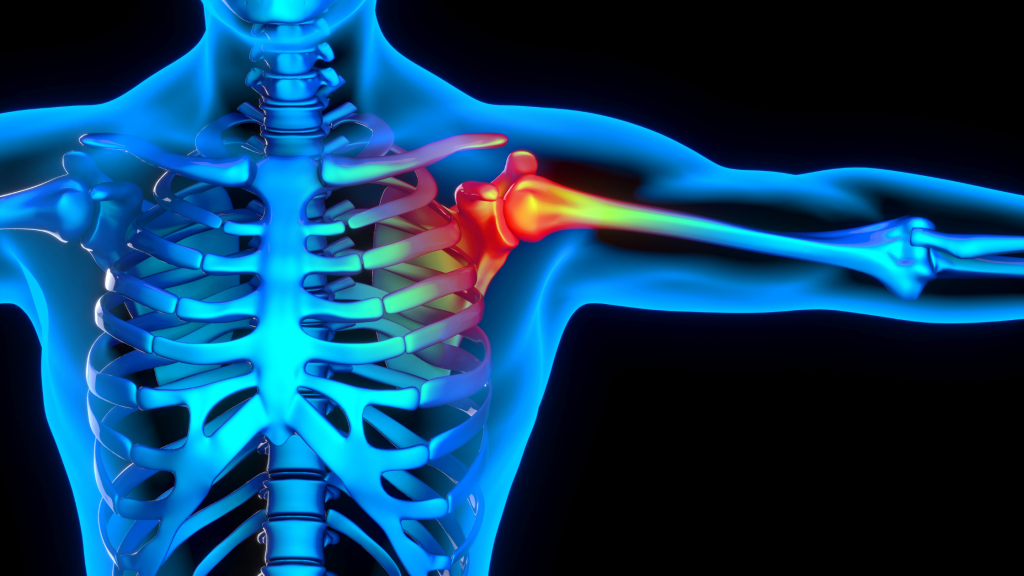




Pingback: What is Spondylosis Cervical? 6 Easy Exercises for Quick Relief - Physiosunit
Pingback: Chronic Back Pain Exercises - Physiosunit
Pingback: How to Cure Back Pain Fast at Home? 7 Tips for Quick Relief - Physiosunit
Pingback: What are Muscle Knots? How to Cure Myofascial Trigger Points - Physiosunit
Pingback: Left Upper Back Pain? 5 Stretches, tips to give instant relief : Physiosunit
Pingback: What is the Best Exercises for Carpal Tunnel : Physiosunit
Pingback: Reverse bad posture permanently using this device: Strack review : Physiosunit